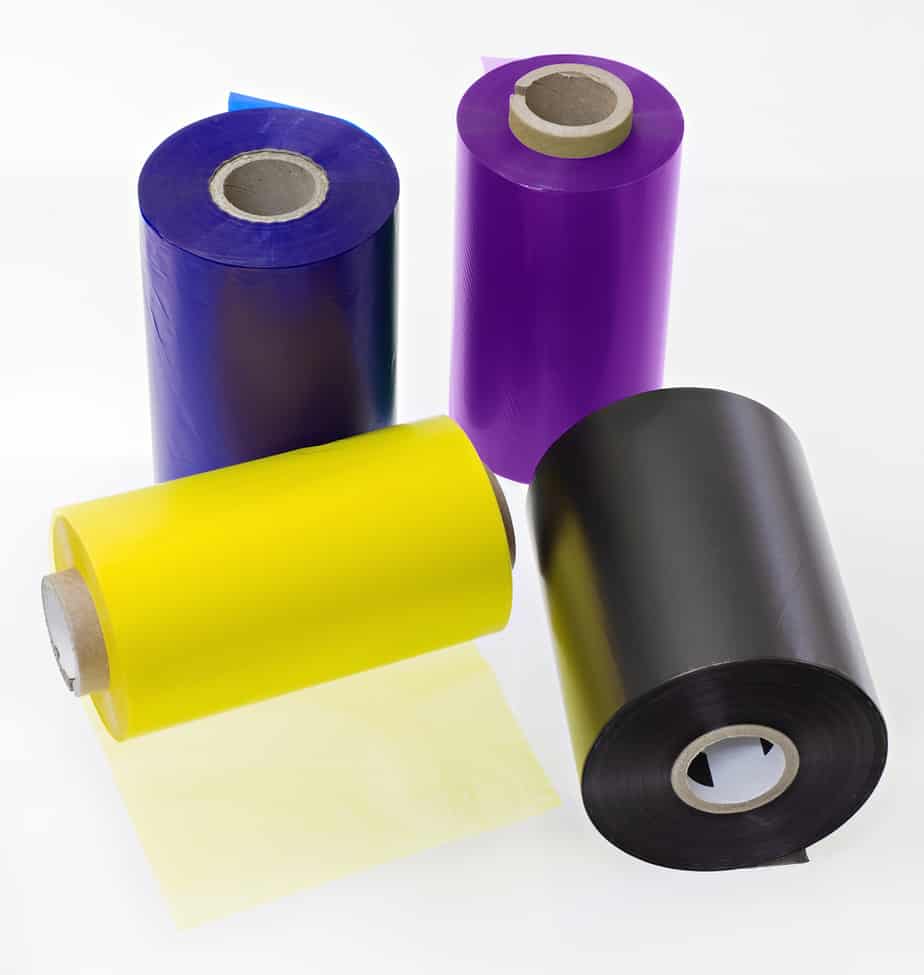This post may contain affiliate links, which means that we get commissions for purchases made through such links, at no additional cost to you. As an Amazon Associate we earn from qualifying purchases.
If you want to learn about wax ribbons, this is the article you should read. Our team has done a comprehensive study on wax ribbons and the other types of thermal transfer ribbons available on the market. In this article, we explain everything you need to know about wax ribbons and thermal transfer ribbons in general.
What is wax ribbon? Wax ribbon is a thermal transfer ribbon made of wax material. It is the most economical type of thermal transfer ribbon. Though cheap, wax ribbon is also less durable that other types of thermal ribbons. It is very soft and often prone to scratching and smudging.
Despite their apparent shortcomings, wax ribbons are still suitable for general applications. They are also the most commonly used type of ribbon material. Read on to find out some key facts about wax ribbons, including their advantages and disadvantages.

What You Should Know about Wax Ribbons
Thermal transfer ribbons are made of polyester films that have been coated with a ribbon material. In the case of wax ribbons, the coating material is used wax. This type of ribbon is a good choice for general applications, including retail, shipping, and address labels.
Here are a few key facts about wax ribbons:
They Are Cheap and Popular
Wax ribbons are the most common thermal transfer ribbon type because they sell for a cheap price. People use them to print on both uncoated and coated paper stock, as well as cards. They are used for a wide variety of applications, including shipping, retail, warehouse, shelf, and bin labels.
They Are Good But Have Limitations
Wax ribbons may have a low melting point but they still adhere well to papers. You can use them on matte and semi-gloss tags and labels and tags. But you should not use them on plastic or glossy material because they might not stick. They don’t stick well on synthetic materials generally.
Many Options Are Available
Since lots of people buy wax ribbons, they are the most marketable of all thermal ribbon types. So manufacturers make a wide range of lengths, widths, and colors available. You wouldn’t have a hard time getting your preferred color and ribbon specifications. And since there are different widths available, you can easily find the perfect width for your tag or label.
They Are Good For Your Printer
Wax ribbons melt at a lower temperature than other ribbon types. So if you are using wax ribbons, your printer’s heat setting can be set on a low level. This will increase the lifespan of your thermal printhead and promote energy savings.
They Are The Least Durable
Wax ribbon is not the best in terms of quality and durability. Wax melts at a lower temperature than resin. This means that wax ribbons are less stable under high-temperature conditions. That is why they are less durable and often result in lighter prints.
They Are Vulnerable
You should keep wax ribbons in dry environments, under room temperature conditions. Avoid contact with oils or chemicals to prevent the wax from dissolving. After printing with a wax ribbon, also keep the label in similar storage conditions to prevent the wax imprint from dissolving.
They Don’t Work With Near-edge Printers
Near-edge printers can print without leaving a border at the edge of your label. This functionality is good but you can’t use a wax ribbon for near-edge printing. You would need a wax/resin or full-resin ribbon for near-edge printing.
How Do Wax Ribbons Work?
Wax ribbons work by melting under heat and sticking to the label material to create an imprint. As the thermal printhead generates heat, it melts the wax material onto the paper and cools it quickly so that it sticks to the paper.
Wax ribbons work with the thermal transfer technology, which uses ribbon cartridges. These cartridges, including wax ribbon cartridges, contain pigments that have a similar consistency to that of crayons. When you feed your thermal transfer label paper and ribbon into the printer, the machine passes the paper and the ribbon between the platen roller and thermal printhead.
The ribbon is usually between the printhead and the paper. As the paper and ribbon runs through the printer, the printhead releases heat onto the ribbon. The ribbon’s ink would then melt and stick to the label paper. The heat cools quickly so that the wax pigment will remain on the paper as the paper comes out.
What Are The Other Types of Thermal Ribbons?
Wax ribbon is only one out of the three types of thermal ribbons. The other two types are wax-resin ribbon and full-resin ribbon. As the name implies, wax-resin ribbons are coated with both wax and resin ribbon materials. Conversely, full-resin ribbons are coated with only resin ribbon material.
Here’s what you should know about the other types of thermal ribbons
Wax-Resin Ribbon
This type of thermal transfer ribbon combines resin and wax, so it is more durable than the full-wax ribbon. It provides considerable resistance to moisture, scratching, and abrasion. The image it creates is also sharper and clearer.
You can use wax-resin ribbons on various label materials and for different conditions. It can withstand extreme conditions, including freezers and industrial refrigerators. If your application requires frequent or heavy handling, wax-resin would be a better choice than wax ribbons.
What You Should Know About Wax-Resin Ribbons
- They are perfect for a wide variety of label materials, including weatherproof and standard thermal transfer rolls.
- The printed area is harder than wax print, so it holds up better to moisture, heavy handling, and moderate changes in temperature.
- Their cost is intermediate. Wax-resin ribbons are more expensive than wax ribbons but cheaper than full-resin ribbons.
- They are ideal for standard/medium-term use and indoor applications.
- Wax-resin ribbons are ideal for shipping, barcode, shelf, and prescription pharmaceutical labels.
Resin Ribbon
The resin (or full-resin) ribbon has a full-resin coating. The ink ribbon is pure resin, which has a higher melting point than wax. They do not only stick to the surface of the label material, but they dissolve into it. This makes them very durable.
While they are the best quality of thermal transfer ribbon available, resin ribbons are quite expensive. You should only use them when the situation calls for it. If your printing project doesn’t require durability, you should go for cheaper ribbon types.
What You Should Know about Resin Ribbons
- Resin ribbons are the most expensive thermal ribbon type
- They are good for printing on non-paper media, such as synthetic stocks
- They make very durable imprints that last longer than all other ribbon types
- Resin ribbons are ideal for printing labels for chemicals, medical applications, flexible packaging, garments and textiles, and automotive.
- Good for permanent or long-term applications
- They can endure both indoor and outdoor applications, scratching, sunlight, moisture, water, abrasion, handling, UV exposure, extreme temperatures, chemicals, and medical machinery.
✅ Video – Thermal Ribbon Types
This video contains all the basic things you should know about thermal transfer ribbons. What are the different types? How are they different? Which type should you use for your label production? What are the recommended label stocks for each type? You will find all the answers in this video.
Related Questions
What Do CSI and CSO Mean?
CSI stands for “carbon side in” while CSO stands for “carbon side out”. These terminologies refer to the ribbon surface that contains the ink. CSI ribbons have the ink in the outer surface of the roll while CSO ribbons have the ink in the inner surface of the roll.
It is easy to recognize the coated side of the ribbon. Usually, one side is dull while the other is shinier. The dull side is the side that contains the ink pigment. This side should face your label sheets when you’re printing. The difference between CSI and CSO is how you will wind the ribbon to make the coated side face the label sheets.
Knowing whether your printer’s specification is CSO or CSI helps you to wind the ribbon in the correct direction. Most printers work only with one configuration: CSO or CSI. Your printer’s brochure or manual should contain this information.
How To Store Thermal Ribbon Stock?
You should store your thermal ribbon stock at room temperature. Also, keep the stock away from direct sunlight and high humidity. This is the ideal storage condition to improve the lifespan of your ribbon stock.
Under direct sunlight, thermal ribbons might not last for more than 24 hours. Sunlight and high temperature is the greatest danger to thermal ribbons. You should be more cautious with sunlight exposure if you are using wax ribbons.
Do All Thermal Printers Use Ribbon?
Only thermal transfer printers use ribbons. Direct thermal printers do not use thermal ribbons. Rather, they use special direct thermal papers that contain heat-sensitive pigments.
Thermal transfer printers use ribbons that melt under heat to produce images on labels. The direct thermal technique, on the other hand, uses heat-sensitive media instead of ribbons. The heat-sensitive pigments in the media darken to create imprints when heat from the printhead activates them.
Conclusion
If you are using or planning to use thermal transfer printers, you would need to buy thermal transfer labels and ribbons. The most common ribbon type is the wax ribbon, which we have discussed extensively in this article. When you compare them with the other label types, you will know if they are appropriate for your printing application or if another ribbon type would be better.
